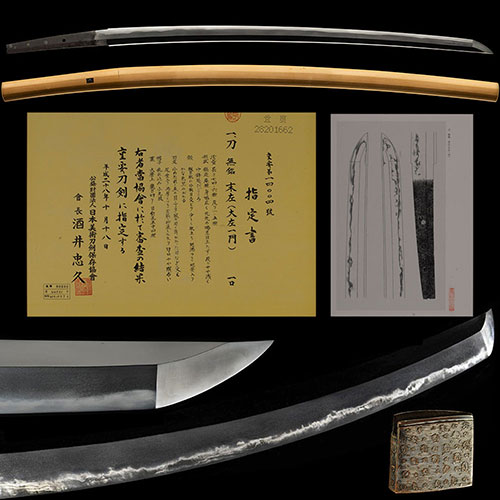
末左 刀Suesa Katana
No.316627刀 大左一門 身幅3.5cm 重量900gの豪壮最高傑作 二尺四寸六分Katana Oh-sa school Mihaba 3.5cm weight 900g Magnificent masterpiece 74.6cm
ご成約Sold
関連商品
- 極めKiwame
- 末左(大左一門)Suesa(Oh-sa school)
- 登録証Registration
- 兵庫県 Hyogo 昭和40年10月7日 10/7/40(Showa)
- 時代Period
- 南北朝時代Nanbokucho period
- 法量Size
-
刃長 74.6cm (二尺四寸六分) 反り 1.7cm
元幅 3.5cm 先幅 2.4cm 元重 0.68cm 鎬厚 0.78cm 先重 0.45cm 鋒長 4.3cm 茎長 19.8cm 重量 900gHachou 74.6cm (二尺四寸六分) Sori 1.7cm
Moto-Haba 3.5cm Saki-Haba 2.4cm Moto-Kasane 0.68cm Shinogi-Thikess 0.78cm Saki-Kasane 0.45cm Kissaki-Chou 4.3cm Nakago-Chou 19.8cm Weight 900g - 国Country
- 筑前Chikuzen
- 姿Shape
- 鎬造、庵棟、身幅広く、反りやや深く、腰反りつき、中鋒延びる。Shinogidukuri, Iorimune, Wide Mihaba, Slightly deep Sori, Chu-Kissaki extended.
- 鍛Kitae
- 板目肌に、小杢目交じり、地沸微塵につき、地景よく入り、淡く映りたつ。Itamehada, Mixed Small-Mokume, Jinie entered finely, Chikei entered well, Faintly Utsuritatsu.
- 刃文Hamon
- のたれて、互の目に、小互の目・丁子刃など交じり、湯走り・二重刃掛かり、足・葉よく入り、沸深くよくつき、所々叢沸がつき、金筋・沸筋・砂流し頻りにかかり、匂深く、匂口明るい。Notarete, Gunome, Small-Gunome, Mixed Choujiba, Yubashiri, Nijuba-kakari, There are many Ashi and You well, Deep Nie entered well, Muranie is attached here and there, Kinsuji, Niesuji, Sunagashi-shikirini-kakari, Deep Nioi, Nioikuchi is bright.
- 帽子Boushi
- 乱れ込んで小丸。Midarekonde-Komaru.
- 茎Nakago
- 大磨上、先切、鑢目切、目釘孔五内四埋。Oh-suriage, Sakikiri, Yasurimegiri,Four of the five Mekugiana are filled
- ハバキHabaki
- 銀色絵一重。Silver-Iroe single layer
- 説明Drscription
- 筑前国左文字は、大左と通称され、実阿の子と伝え、銘文の左は、左衛門三郎の略という。相州正宗十哲の一人に数えられ、それまでの古典的な九州物の作域から大いに脱皮し、地刃共に明るく冴え、地景や金筋の目立つ新作風を確立した。現存する在銘の太刀は、国宝の「江雪左文字」のみであるが、短刀の作例は比較的多く残されている。左一門は、師風を受け継いで作刀し、南北朝期に大いに栄えた。大左の子と伝える貞吉・安吉を始め弘行・国弘などがいて、これらを末左とも呼称する。この刀は、元は三尺を超える太刀であったと思われ、身幅3.5cmと非常に広く、磨上げて尚重量が900gもあり、鋒延びる南北朝時代の豪壮な姿で、板目のつんだ鍛えに、小杢目交じり、地沸が微塵に厚くつき、地景がよく入り、肌だちごころに、映りが立つ地鉄に、のたれて、互の目・角がかった刃・丁子刃などが交じり、湯走り・二十刃かかり、地刃の冴えと働きには抜群のものがあり、力強く、覇気溢れ、働き盛な刃を焼く傑作である。左文字に極まってもよい出来の傑作である。Chikuzennokuni Samonji is commonly known as Ohsa and is said to be a child of Jitsua, and the inscription Sa is an abbreviation for Saemon saburou. He was one of Sousyu Masamunejittetsu, and he was a big break from the classic Kyusyu production area, and he was bright and clear with Jiba, establishing a prominent new style of Chikei and Kinsuji. The only existing Tachi in existence is the national treasure "Kousestsu Samonji", but there are relatively many examples of Tantou. The Sa family prospered greatly during the Nanbokuchou period, but there are Sadayoshi, Yasuyoshi, Hiroyuki, Kunihiro, etc. who are said to be children of Ohsa, and these Sa families are called Suesa. This sword is thought to have originally been a Tachi over 3 shaku, Very wide at 3.5cm Mihaba, Suriage weighs as much as 900g,With the magnificent appearance of the Nanbokucho period, Itame-tsunda Kitae, Mixed small-Mokume, Jinie entered fine and thick, Chikei entered well, Hada-dachiigokoro, Utsuritatsu Jitetsu, Notare, Gunome, Angular blade, Mixed Choujiba, Yubashiri, Nijuba-kakari, Jiba is clear and Hataraki is outstanding, It is a masterpiece of a powerful, ambitious, It works well in sword. It is a masterpiece that could only be surpassed by Samonji.



